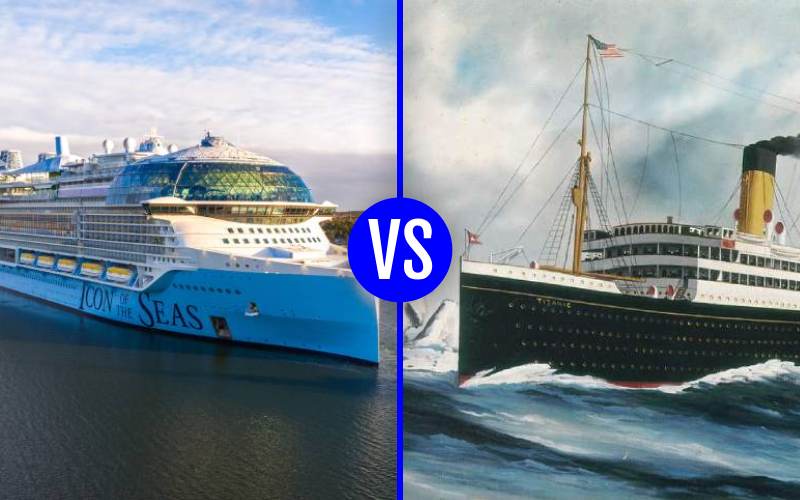Have you ever wondered how the Titanic, once deemed the “unsinkable” ship, stacks up against the Icon of the Seas? The Titanic, launched in 1912, was a marvel of its time, and was famed for its grandeur and supposed invincibility.
In contrast, the Icon of the Seas, which entered service in January 2024, is currently the world’s largest cruise ship. The ship is the pinnacle of modern cruise ships, setting a new standard for size and amenities. It boasts eight distinctive “neighborhoods” including Thrill Island and Chill Island, catering specifically to varied passenger experiences. For families, it offers unique accommodations like the first-ever three-level Ultimate Family Townhouse. Additionally, with more than 20 dining venues, the ship ensures a broad spectrum of culinary delights, from casual bites to upscale dining.
This article will compare the Titanic and the Icon of the Seas in terms of dimensions, design, amenities, and safety features. It will illustrate the dramatic evolution in cruise ship design from the early 20th century to today, focusing on the overall passenger experience.
Icon of the Seas vs. Titanic: Cruise Ship & Ocean Liner
The Titanic was an ocean liner, while the Icon of the Seas is a modern cruise ship. The primary role of ocean liners like the Titanic was to transport people and mail across oceans as quickly and efficiently as possible, often braving rough seas. On the other hand, cruise ships such as the Icon of the Seas are built for comfort and entertainment, focusing more on the journey itself than the destination.
Royal Caribbean’s new ship, Icon of the Seas, stands out with its massive size, spanning 20 decks, and is the first in their Icon Class line of ships. Its design as a floating island offers a multitude of activities, venues, and entertainment options, aiming to deliver an unforgettable experience at sea. Scheduled to be joined by its sister ship, Star of the Seas, in 2025, the Icon of the Seas represents the modern shift in cruise ships from mere transportation to a comprehensive vacation experience, a stark contrast to the historical and utilitarian nature of the Titanic.
Icon of the Seas vs. Titanic: Size
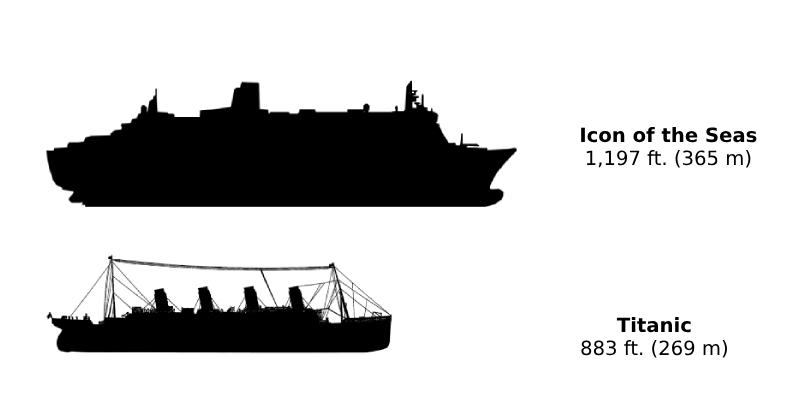
Gross tonnage
When comparing the size of the Titanic to that of the Icon of the Seas, gross tonnage (GT) provides the most reliable measurement. Gross tonnage is a measure of a ship’s overall internal volume, including all passenger spaces, crew accommodations, and operational areas.
The Titanic, which sailed over a century ago, was one of the largest ships of its time, with a gross tonnage of 46,329. In contrast, the Icon of the Seas significantly dwarfs the Titanic, with a gross tonnage of 248,663. This makes the Icon of the Seas around 5.3 times larger than the Titanic.
Showcasing its huge scale, the Icon of the Seas not only surpasses the Titanic, but it also currently holds the title of the largest cruise ship in the world. The second-largest, the Wonder of the Seas, comes in with a gross tonnage of 235,600. This enormous scale of modern cruise ships shows just how much the industry has evolved.
Interestingly, if the Titanic were compared with today’s cruise ships, its gross tonnage would not place it within the top 64 largest cruise ships currently in service!
Length

The Titanic was a massive ship back in 1912, stretching 882 ft. (269 m) long. Today, the Icon of the Seas far surpasses that, measuring 1,196 ft. (364 m) in length. This makes the Icon of the Seas 312 ft. (95 m) longer than the Titanic, which is a 35% increase.
Although the Icon of the Seas is much longer than the Titanic, the difference isn’t very huge when compared to GT (gross tonnage). The average cruise ship now is about 1,000 ft. (304 m) long. This shows that today’s ships, while bigger, haven’t grown in length too much more than those from a century ago.
The primary reason why modern cruise ships, like the Icon of the Seas, aren’t significantly longer than the Titanic relates to the constraints of port infrastructure. Many ports simply cannot accommodate very long ships, which naturally restricts the maximum length of new ships. As a result, cruise lines have adapted by constructing ships that are taller and have more decks, rather than greatly extending their length. This approach allows for more amenities and passenger capacity without the need for longer docks.
Beam (Width)
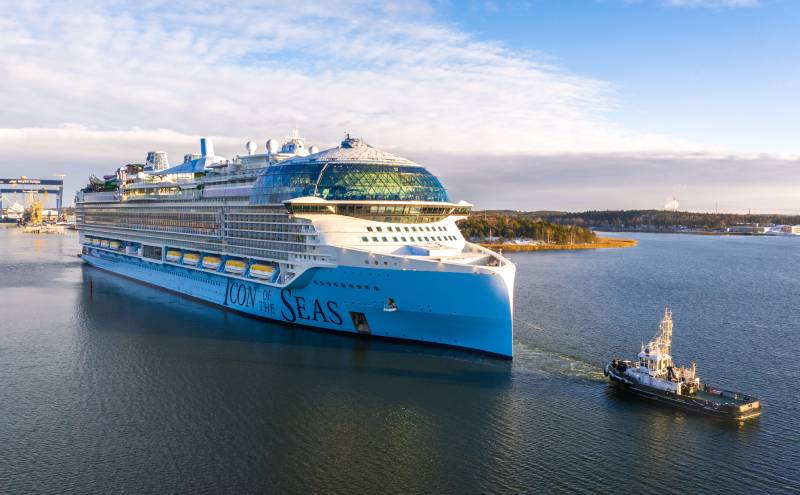
When it comes to the width of these famous ships, also known as the beam, the Titanic and the Icon of the Seas are quite different. The Titanic, which tragically sank on its maiden voyage in 1912, measured 92 ft. (about 28 m) across. This width was considered massive at the time, fitting the ship’s status as one of the largest floating objects ever built by the time of its launch.
In contrast, Royal Caribbean’s Icon of the Seas significantly surpasses this. The Icon of the Seas boasts a beam of 159 ft. (48 m). This makes it 66 ft. (20 m) wider than the Titanic. To put it into perspective, this increase in width is a staggering 71% more than that of the Titanic, showcasing just how much cruise ship design and construction have evolved and expanded over more than a century.
Furthermore, even the smallest ship in the Royal Caribbean fleet, the Majesty of the Seas, has a beam measuring 105 ft. (32 m). This width still exceeds the Titanic’s by 13 ft. (4 m), showing that even the smallest ships today are built larger than some of the most iconic ocean liners of the past.
Draft
The draft of a ship refers to the distance between the waterline and the lowest part of the ship’s hull. This measurement determines the minimum depth of water a ship requires to float without touching the bottom.
For example, the Titanic had a draft of 33 ft. (10 m). This means it needed at least 33 ft. (10 m) of water to float freely. Comparatively, the Icon of the Seas has a draft of 30 ft. (9 m), which is slightly less than the Titanic.
Despite modern advances in ship design and building, the draft of big ships like the Titanic and today’s large cruise ships has not changed much. These ships are still made to have a draft that allows for good stability and speed, and to fit in various harbors without trouble.
Height
The Titanic was a massive ship, about 141 ft. (43 m) tall from the waterline to the top of its four iconic funnels. These funnels themselves contributed significantly to its height, each standing about 63 ft. (19 m) high. Without these towering funnels, the ship’s height from the waterline was roughly 78 ft. (24 m).
In comparison, the Icon of the Seas stands at 196 ft. (60 m) tall above the waterline. This makes it approximately 56 ft. (17 m) taller than the Titanic, which translates to a 39% increase in height. The Icon of the Seas shows how cruise ships have grown much taller as the demands for larger, more luxurious passenger accommodations have increased.
Decks
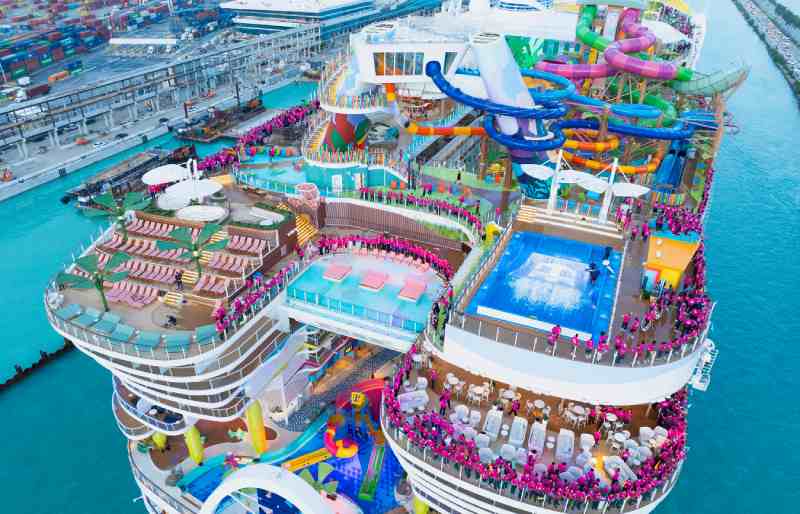
The Icon of the Seas has a total of 20 decks, the most on any cruise ship:
- Decks 2 & 3 are fundamental for operations and accessibility, featuring crew and tendering facilities, essential cabins, dining venues, a music hall, and the hospital.
- Decks 4 & 5 expand guest accommodations and leisure, including more cabins, additional dining areas, a casino, and the vibrant Royal Promenade, which includes shops and a gym, serving as the social and commercial hub of the ship.
- Decks 6 to 8 focus on family and relaxation, continuing the Royal Promenade and featuring zones like Surfside and Splashaway for water fun, plus Central Park for tranquil, open-air enjoyment.
- Decks 9 to 14 are predominantly reserved for cabins and wellness facilities, including two spas that offer treatments and relaxation with stunning views.
- Decks 15 to 18 are entertainment and luxury-centric, featuring the innovative AquaDome, AquaTheater, and multiple pools. These decks also include exclusive suites, a golf course, Thrill Island, and various sports facilities, encapsulating the high-end leisure facilities of the ship.
- Decks 19 & 20 cap off the accommodation and entertainment offerings with expansive suite sundecks and a high-thrill Category 6 waterpark, providing panoramic views and ultimate water fun.

The Titanic featured a total of 9 decks:
- Boat Deck: The uppermost deck of the Titanic was around 500 ft. (152 m) long. It was primarily used to house the lifeboats and offer unobstructed views of the sea.
- A Deck (Promenade Deck): Also around 500 ft. (152 m) in length, this deck featured extensive promenade areas for first-class passengers, enclosed by a long, covered promenade that ran along the sides of the superstructure.
- B Deck: This deck extended about 550 ft. (168 m). It housed passenger accommodations, public rooms, and a spacious open promenade.
- C Deck: The complete length of the ship, accommodating more passenger quarters, including the third class and crew spaces.
- D Deck: Also spanning the ship’s full length but tapered down at the ends, this deck included dining saloons and other public spaces.
- E Deck: Ran the entire length of the ship, housing further passenger cabins and was partially above the waterline at midship.
- F Deck: This lower deck also extended along the whole ship and included crew accommodations, cargo holds, and machinery.
- G Deck and Orlop Deck: These lower decks were significantly shorter, roughly 190 ft. (58 m) forward and 210 ft. (64 m) aft, mainly used for storage and machinery.
Passenger capacity
The Titanic could carry up to 2,435 passengers. Including the 900 crew, the ship could carry up to 3,300 individuals. On the other hand, the Icon of the Seas, a modern cruise ship, has significantly higher capacity. At double occupancy, it can hold 5,610 passengers, and at maximum capacity, this number increases to 7,600. In addition, the ship accommodates a crew of 2,350.
To put it into perspective, the Icon of the Seas can hold a lot more people than the Titanic. At its standard capacity, the Icon of the Seas carries 130% more passengers than the Titanic, jumping from 2,435 to 5,610 passengers. At full capacity, it can carry 196% more passengers, with numbers increasing to 7,600 compared to the Titanic’s 2,435. Including its crew, the Icon’s maximum capacity of 7,600 is 130% higher than the Titanic’s total of 3,300 people.
Icon of the Seas vs. Titanic: Construction & Engineering
Shipyard and Construction Location
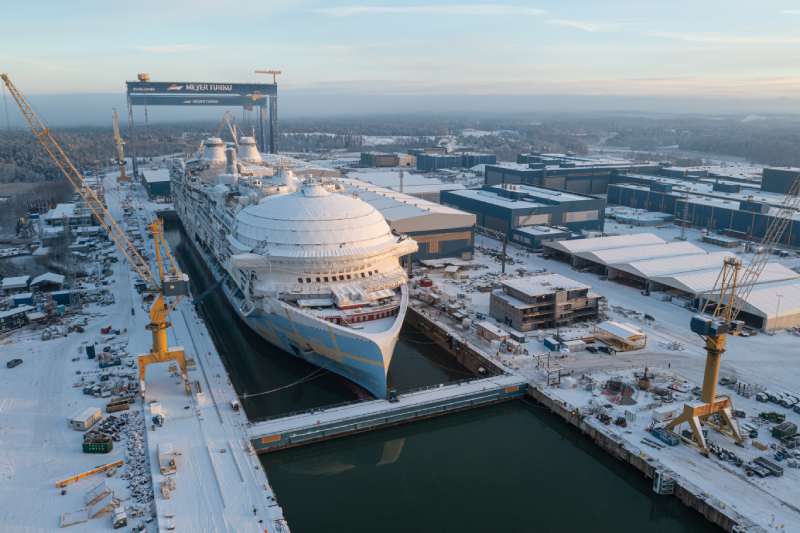
In contrast, the Icon of the Seas was built by Meyer Turku in Turku, Finland. Meyer Turku is responsible for some of the most iconic cruise ships of the 21st century, such as Allure of the Seas and Carnival Celebration. The Icon of the Seas cost $2 billion to build, showing that modern ships are much more expensive due to their complex features and technology. The ship took about 900 days (almost two and a half years) to build.

The Titanic was constructed at the Harland & Wolff shipyard in Belfast, Northern Ireland. Known for building some of the most famous ships of the early 20th century, such as the RMS Olympic and RMS Britannic, the shipyard built the Titanic at a cost of $7.5 million in the early 1900s, equivalent to about $200 million today when adjusted for inflation. Construction began in 1909 and took about 26 months (just over two years) to complete, during which sadly, eight workers died.
Hull Design & Compartments
The Titanic was known as the “unsinkable” ship because of its special design, which included a double-bottom hull and 16 watertight compartments. These features were supposed to keep the ship floating, even if part of it was filled with water. The doors of these compartments were designed to close manually or automatically at the water level.
However, there was a big problem with this design—the tops of these watertight compartments were not sealed. This meant that when the ship’s hull was damaged and water began to fill the compartments, the water could spill over into the next compartment as the ship tilted. This flaw allowed water to flood more and more of the ship, which eventually caused the Titanic to sink.
Today’s ships, like the Royal Caribbean’s Icon of the Seas, have come a long way since the Titanic. The Icon of the Seas also has a double hull and watertight compartments, but it also includes modern technologies like a robot to clean the hull and an air lubrication system that helps reduce drag in the water. This ship will also be the first in Royal Caribbean’s fleet to have a parabolic bow.
Welds vs. rivets

When the Titanic was constructed, it used over three million rivets, which are small metal pins that fasten together pieces of metal. These rivets were hammered in manually, which took a lot of time and limited the types of metal that could be used. The rivets made from iron were especially risky because they could break under too much pressure or in extremely cold temperatures like those the Titanic faced when it hit the iceberg. This weakness played a big part in the ship’s hull ripping apart, which led to the disastrous sinking.
Today, modern ships like the Icon of the Seas use welding instead of rivets. Welding melts the metal pieces together to form a solid bond that’s much stronger and lasts longer than riveted joints. This method helps the ship withstand very high pressures and temperatures and reduces the chance of the metal breaking like it did on the Titanic. Welded ships are safer and sturdier, making them better suited for the harsh conditions at sea.
Propulsion and Power Systems
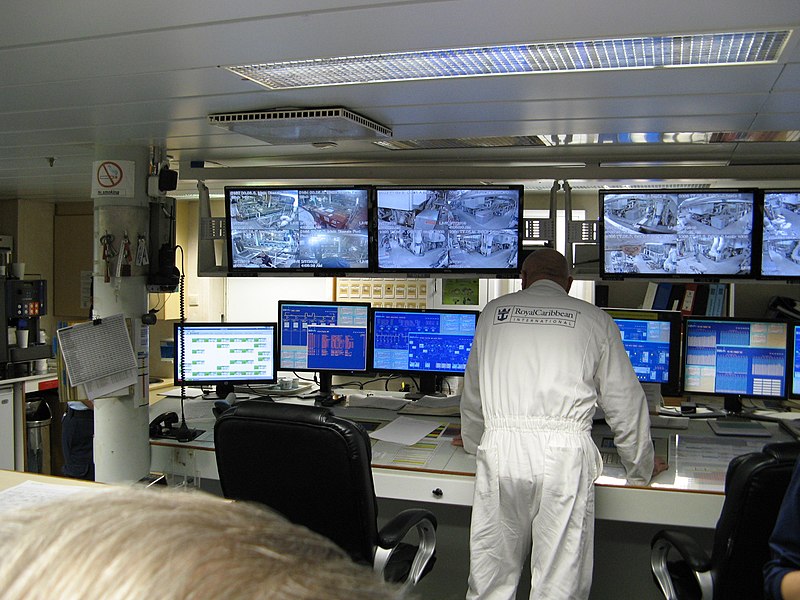
The Titanic was propelled by a combination of steam reciprocating engines and a Parsons steam turbine. Two massive four-cylinder reciprocating engines, each generating 15,000 horsepower, powered the wing propellers, weighing 38 tons each and measuring 23 ft. (7 m) in diameter. Additionally, a low-pressure Parsons steam turbine, using exhaust steam from the reciprocating engines, provided an extra 16,000 horsepower, operating at 160 to 180 revolutions per minute.
Unlike the Titanic, which used coal-fired steam engines, the Icon of the Seas is powered by six advanced LNG-fueled engines. These engines on the Icon of the Seas will collectively generate an impressive 67,500 kW of energy. LNG, or liquefied natural gas, is a form of natural gas primarily composed of methane that has been cooled down to liquid form. This will be Royal Caribbean’s first LNG-powered ship.
Stability and Maneuverability
The Titanic, built over a century ago, had limitations in stability and maneuverability compared to modern cruise ships like the Icon of the Seas. The Titanic’s design and technology at the time didn’t allow for the advanced stability features that modern ships have. For instance, it lacked the sophisticated ballast systems used today that help keep ships stable and upright in rough waters. This means the Titanic could not adjust as quickly or as effectively to changes in water conditions, which contributed to its vulnerability when it struck an iceberg.
On the other hand, the Icon of the Seas benefits from the latest advancements in maritime technology, making it far more stable and easier to maneuver. Modern cruise ships are equipped with state-of-the-art stabilizers that significantly reduce the rolling motion caused by waves, enhancing passenger comfort and safety. Additionally, they have powerful, computer-controlled propulsion systems that allow for precise movements and adjustments. This high level of maneuverability helps modern ships avoid hazards that the Titanic could not, providing a safer and smoother experience for passengers.
Icon of the Seas vs. Titanic: Interior Design
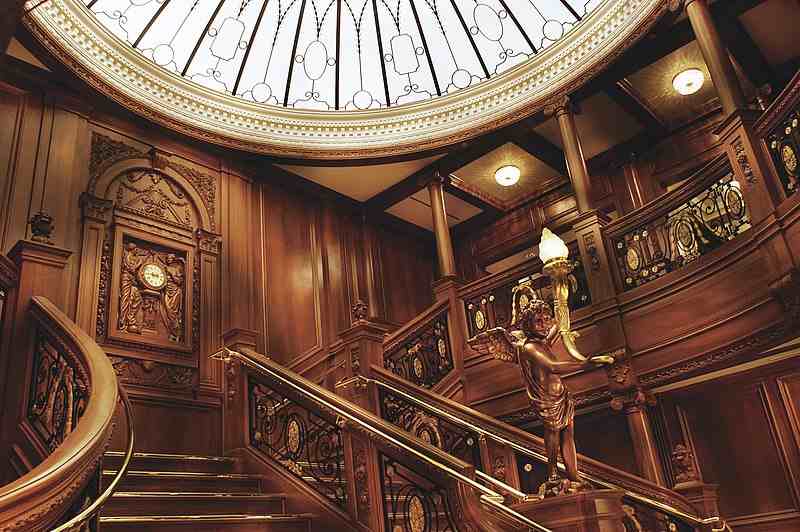
The Titanic set the standard for luxury ocean travel with its interior, similar to that of a grand hotel. The grand staircase, an elegant feature that spanned seven decks, showcased solid oak craftsmanship, iron railings, and an opulent glass dome ceiling. Inspired by Edwardian architecture, the interior featured ornate aesthetics and high-quality furnishings to appeal to the elite.
Fast forward more than a century, and the Icon of the Seas offers a modern take on interior design to reflect modern architectural trends and passenger tastes. Unlike the Titanic’s classic and opulent design, the Icon of the Seas incorporates modern elements like the AquaDome, which provides panoramic ocean views under a large glass roof. Another notable feature is The Pearl, a 52 ft. (16 m) diameter steel sphere designed to resemble a pearl, taking over two years to complete.

The Icon of the Seas also embraces unique themed neighborhoods such as The Hideaway and Central Park. The Hideaway is designed as a vibrant beach club with an infinity swimming pool that overlooks the ship’s wake and is perched above the Surfside family area, featuring a bar, lounges for sunbathing, whirlpools, and the promise of legendary parties.
Central Park, a favorite from past ships, offers a tranquil escape with paths among live vegetation, soft music in the evenings, and balconies that extend over the park, providing a more affordable alternative to ocean view balconies while maintaining an immersive experience with nature, shopping, and dining.
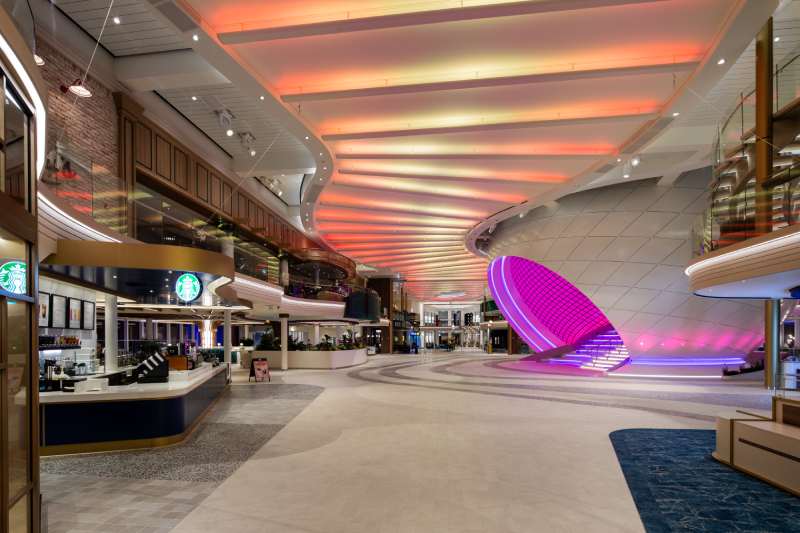
The Royal Promenade on the Icon of the Seas has been upgraded with floor-to-ceiling glass windows that flood the space with natural light and offer expansive ocean views, making it feel more open and welcoming compared to traditional designs.
Additionally, the Suite Neighborhood provides exclusive amenities like upscale dining, private swimming pools, and sundecks for suite guests, tailored to provide personalized luxury experiences. These enhancements represent a shift from the Titanic’s uniform luxury to a more customized, modern approach to cruise ship design.
Icon of the Seas vs. Titanic: Onboard Experience
Cabin facilities
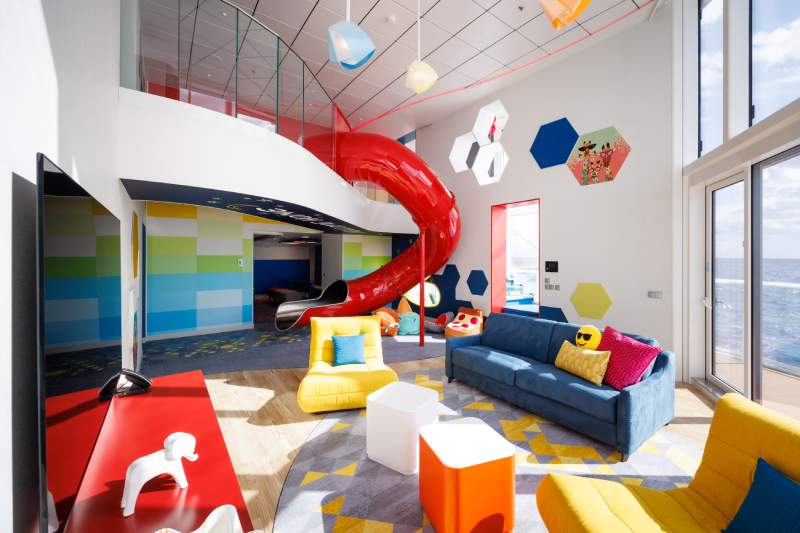
Guests aboard the Icon of the Seas can select from 28 cabin types, categorized into interior, oceanview, balcony, and suites. The most luxurious option is the Ultimate Family Townhouse. This spacious suite covers three floors and 1770 square feet (164 square meters), and includes a large 750-square-foot (70 square meter) balcony. It can accommodate up to eight guests and features exciting amenities like an indoor slide, a private movie theater with karaoke and a popcorn machine, and a patio that offers direct access to the Surfside Neighborhood.
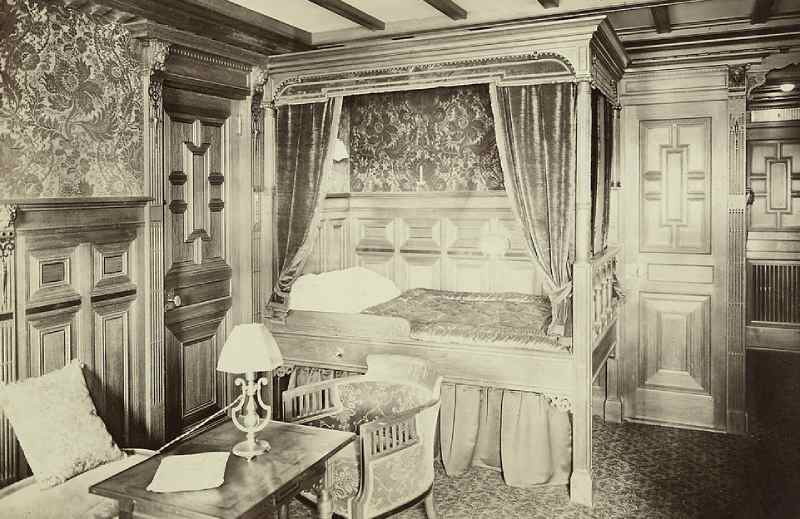
On the Titanic, cabin facilities ranged dramatically across its class system. First-class passengers enjoyed luxurious, spacious rooms with fine furnishings, much like those of a high-end hotel. Those in second class had comfortable quarters with decent amenities such as oak paneling and private washbasins. However, third-class passengers faced more cramped conditions, with small rooms featuring bunk beds and minimal furnishings.
Icon of the Seas vs. Titanic: Speed
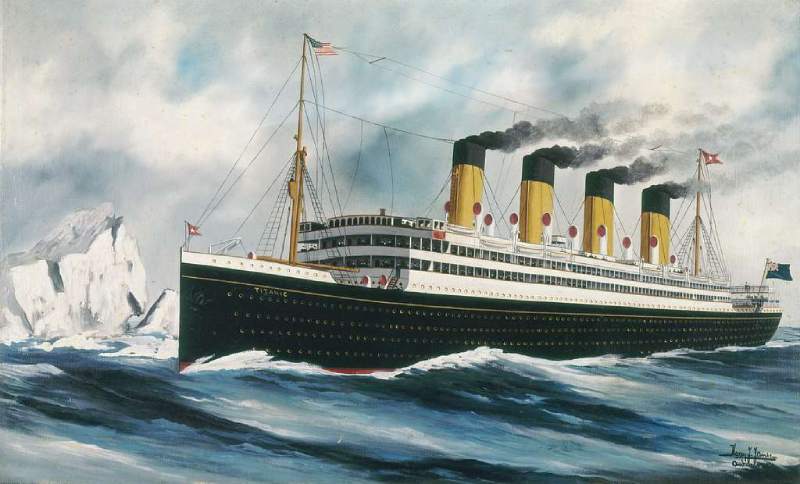
The Icon of the Seas has a top speed of about 22 knots (25 mph or 41 kph). Unlike the ocean liners of the past, modern cruise ships like the Icon of the Seas prioritize features other than speed. Today’s cruise ships are designed more for stability, passenger comfort, and on-board amenities, so speed isn’t as important.
The Titanic had a maximum speed of 23-24 knots (around 26 mph or 42 kph). A high speed was important for transatlantic liners like the Titanic, which aimed to reduce the travel time between Europe and North America.
Icon of the Seas vs. Titanic: Safety Features
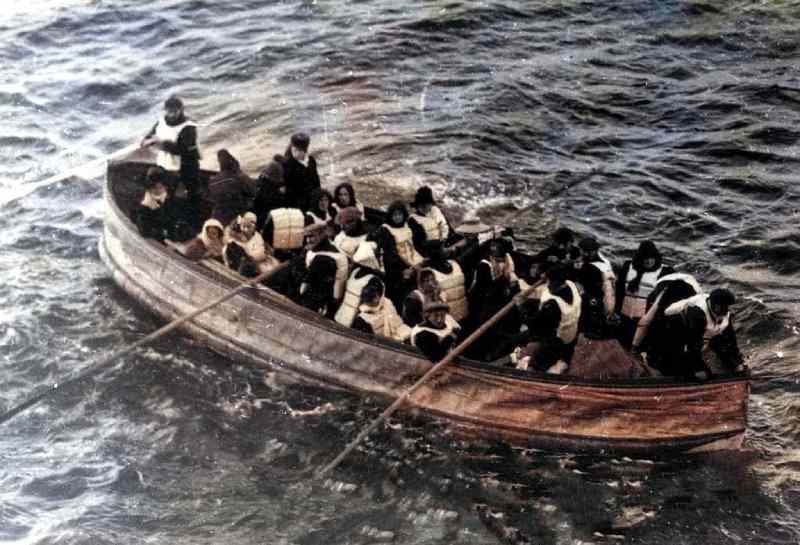
The Titanic was equipped with only 20 lifeboats, which could accommodate less than half of its total passengers and crew. At the time, this number actually exceeded the British legal requirements, which mandated enough lifeboats for only 30% of a ship’s capacity.
The Titanic disaster led to the formation of the International Convention for the Safety of Life at Sea (SOLAS), which established new safety measures to improve ship construction, life-saving equipment, and emergency protocols, ensuring that a tragedy like the Titanic would not happen again.

On the other hand, the Icon of the Seas is equipped with 17 lifeboats, each capable of holding 450 people. This actually isn’t enough for the total ship’s capacity, so not everyone will rely on lifeboats. The ship is designed with escape tubes that lead to rafts. These rafts can fully inflate within 90 seconds and will be used by crew members, as they can be hard to use without training.
Titanic vs. Modern Cruise Ship: Technology
Navigation technology
The Titanic navigated the oceans primarily through celestial navigation. This method depended on observing the stars, sun, moon, and other celestial bodies to figure out the ship’s location in terms of latitude and longitude. Navigators used tools like sextants to measure the angle between these celestial bodies and the horizon. They also relied on chronometers (a type of precise clock) and compasses to help steer the ship’s course.
Celestial navigation required clear skies and visible stars, which made it effective though somewhat imprecise. The Titanic’s navigators also used a technique called dead reckoning. This involved estimating the ship’s current position based on a known past position by using reports on direction and speed. However, these methods did not allow for real-time precision, contributing to the tragic accident.

In contrast, the Icon of the Seas primarily navigates using GPS (Global Positioning System) which provides high-precision, real-time location data via satellites. This system allows for highly accurate tracking of the ship’s position anywhere on the globe.
Additionally, modern ships are equipped with various other technologies. Radar is used to detect other ships and obstacles. Electronic maps provide detailed and up-to-date navigational information. Automatic identification systems (AIS) feature transponders that share the ship’s location with other nearby ships and traffic monitoring centers.
Communication technology
When the Titanic embarked on its maiden voyage in 1912, it was equipped with the latest communication technology of the time: the wireless telegraph. This system was pivotal during the Titanic’s catastrophic final hours, as it allowed the ship to send distress signals to nearby vessels. Despite its advanced capabilities, the technology had its limitations and was primarily used for sending Morse code messages and distress signals.
The wireless telegraph on the Titanic operated by transmitting Morse code messages through radio waves. Morse code encodes text characters as standardized sequences of two different signal durations called dots and dashes or dits and dahs. This system required skilled operators who could swiftly send and receive messages. However, it was not capable of continuous communication; messages had to be sent and received one at a time, and there were often delays, depending on the availability and attention of the operators.
Contrast this with the communication technology aboard Royal Caribbean’s newest vessel, Icon of the Seas. This ship uses modern satellite communications systems that provide continuous, real-time connectivity. Unlike the Titanic, where communication was a tool for operational necessity and emergency, communication on the Icon of the Seas is integral to enhancing passenger experience. The ship is equipped with broadband internet capable of handling high data demands, allowing thousands of passengers and crew to access the web, stream media, and stay connected through social media, all at sea.
Weather forecasting and iceberg monitoring technology
In 1912, the RMS Titanic relied on basic weather prediction and iceberg monitoring technologies. The crew received iceberg warnings through telegraph messages but lacked the tools to pinpoint iceberg locations accurately or quickly. Lookouts had to use binoculars to see icebergs, which were only visible at short distances and in clear conditions.
In contrast, the Icon of the Seas is equipped with advanced meteorological tools such as satellite imagery and radar, which provide real-time and accurate information on weather and potential hazards. This technology enables precise mapping of iceberg locations and offers visualizations of weather conditions days ahead. Modern cruise ships can safely alter their course well in advance to avoid hazards, greatly minimizing the risk of maritime accidents.
Icon of the Seas vs. Titanic: Ticket Price
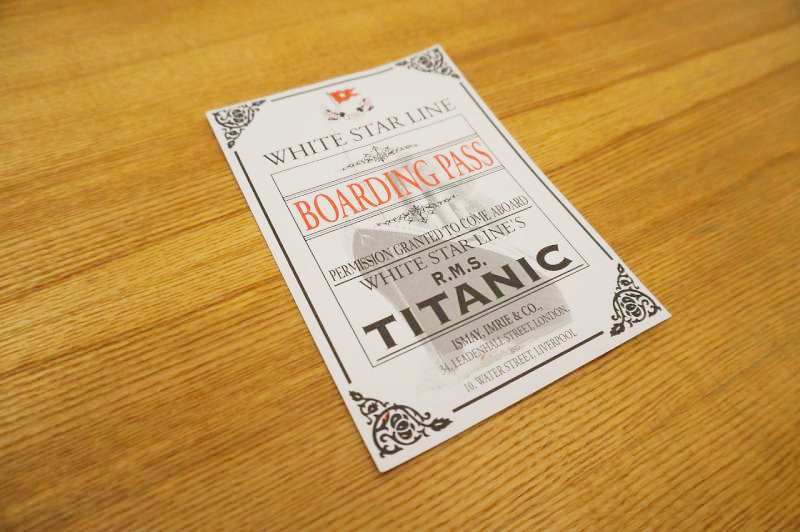
Ticket pricing on the Titanic varied based on the class of service you chose. The pinnacle of luxury, a first-class suite on the Titanic, cost about $4,350, which is equivalent to $133,132 in today’s money. More affordable first-class berths were available for around $150 ($4,591 today). Second-class tickets were more modest but still comfortable, costing $60 (about $1,834 today), while the most economical option, third class, catered to immigrants and lower-income passengers for just $35, or $1,071 today.
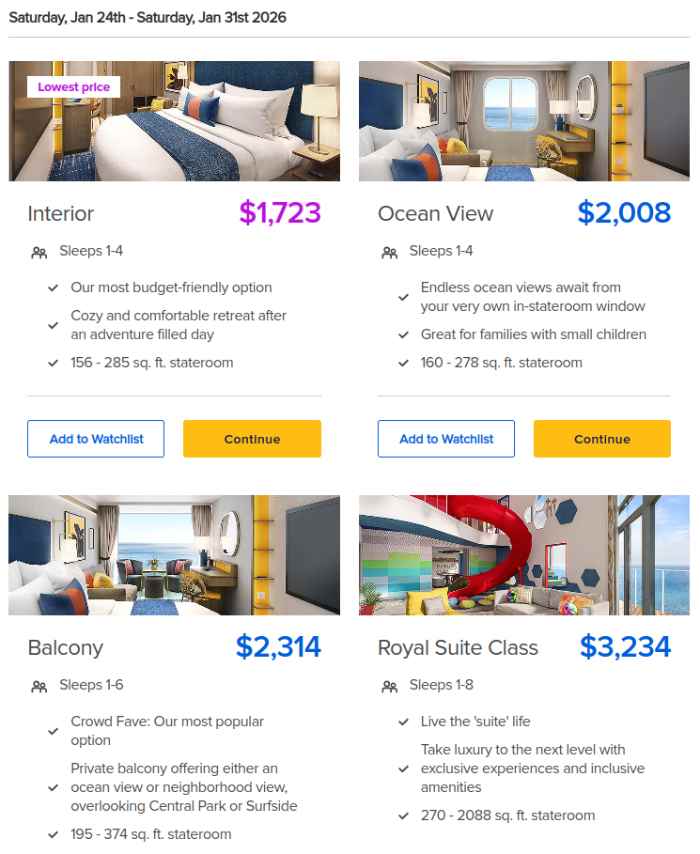
For a modern ship like Icon of the Seas, the price will vary based on the cabin type, destination, and timing of the cruise (peak vs. off-season). For a typical 7-night cruise through the Western Caribbean aboard Icon of the Seas, prices start at $1,723 for an interior cabin. Ocean view rooms are priced slightly higher at $2,008, followed by balconies at $2,314, and royal suite classes at $3,234. The most luxurious option, the Ultimate Family Townhouse, starts at a price of $39,784.
Icon of the Seas vs. Titanic – FAQ
What makes Icon of the Seas unique?
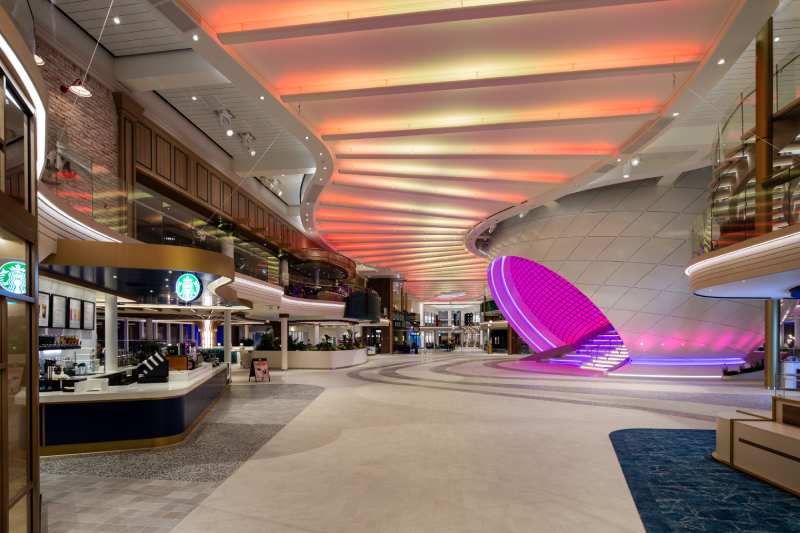
The Icon of the Seas is different for many reasons. It’s the first cruise ship to use liquefied natural gas (LNG). It’s also the largest cruise ship in the world, featuring the biggest waterpark at sea with the tallest waterslide ever on a cruise. The ship includes a special neighborhood just for families called ‘Surfside,’ designed to keep the whole family entertained all day. Additionally, it has the largest pool at sea and the world’s largest kinetic art sculpture.
Is Icon of the Seas larger than Titanic?
Yes, the Icon of the Seas is significantly larger than the Titanic. In terms of gross tonnage, which measures a ship’s internal volume, the Icon of the Seas is about five times larger than the Titanic. Additionally, it is 35% longer and 71% wider than the Titanic.
Who owns Icon of the Seas?
The Icon of the Seas is owned by the Royal Caribbean Group. This impressive cruise ship, which cost $2 billion to construct, officially entered service on January 27, 2024. It was built by Meyer Turku, a well-known shipyard located in Turku, Finland.
What is the most expensive room on the Icon of the Seas?
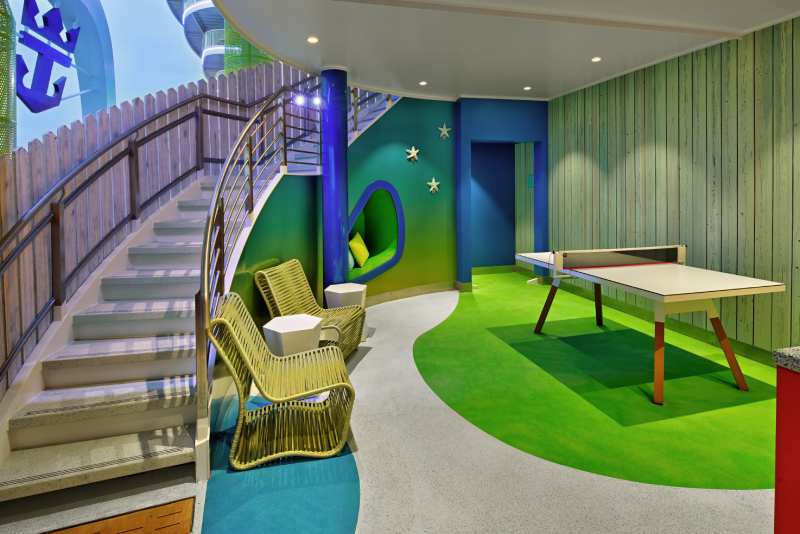
The most expensive room on the Icon of the Seas is the brand new Ultimate Family Townhouse. Typically, this suite will cost about $20,000 to $40,000 per week, depending on the sailing. This three-story suite spans 1,770 square feet and features a vast 750-square-foot balcony. It can comfortably house up to eight guests and comes packed with fun amenities. These include an indoor slide, a private movie theater complete with karaoke and a popcorn machine, and a patio that provides direct access to the Surfside Neighborhood.
How big is the Titanic compared to the Icon of the Seas?
The Titanic is much smaller than the Icon of the Seas when comparing their sizes. In terms of gross tonnage, which measures a ship’s internal volume, the Titanic is about 5 times smaller than the Icon of the Seas. The Titanic measures 882 ft. (269 m) in length, while the Icon of the Seas is much longer at 1,196 ft. (364 m). Additionally, the Titanic’s beam (width), measuring 92 ft (about 28 m), is dwarfed by the Icon of the Seas’ beam of 159 ft. (48 m).
Related articles:

